Interesting ancient coins, offered by Augustus Coins
If you want to buy ancient coins and you are in the US, you are beginning at the right page. If you want to learn more about ancient coins, visit my educational ancient-coin website (begun in 1997 and expanded very many times since then). If you like to learn from books, visit my page of ancient-coin literature. For more about me, see see here.
Contents: This is the main page with Roman coins and some of newest listings from other series too, at the top. For late Roman, Byzantine, or Greek coins, or books about them, use the links to the left.
Skip down to Republican, 1st C, 2nd C, or 3rd C , Tetrarchy (Diocletian - Licinius II). (Links to other series are on the left sidebar.)
Recent: 2024, Oct. 20: Many prices reduced on the Valentinian and later page. Constantine SOLI INVICTO COMITI on the Constantinian page. Crusader of the First Crusade, Bohemond II, on the Byzantine page.
2024, Oct. 17, Rare Justin pentanummium. Scarce Class F anonymous follis. Justinian year 38 from Antioch. Constantius Gallus and Crispus in consular robes on the Constantinian page.
2024, Oct. 16: The crusader Tancred's first type in nice shape and an anonymous Class I on the Byzantine page.
2024, Oct. 9. Anonymous Class G and two(!) Class H on the Byzantine page.
2024, Oct. 8: Leo V (very scarce) and Tancred of the First Crusade on the Byzantine page.
2024, Oct. 3: Theodosius II on the late Roman page.
2024, Sept. 30: Magnentius rarity with two captives on the Constantinian page. The whole Constantinian page redone with coins moved to be in chronological order. Some prices revised. Look under the emperor's name now. Similarly, I revised the "Valentinian and later" page. I removed most sold coins, reorganized it to have almost all the coins listed by emperor, and revised some prices.
2024, Sept. 28: Honorius AE4 at Rome on the Valentinian and later page.
2024, Sept. 25: Tancred, crusader of the First Crusade and rare Maurice from Carthage (none on vcoins) on the Byzantine page. Scarce Cripus and Constans "hut" on the Constantinian page.
2024, Sept. 21: Ancient imitation of an AE2 GLORIA ROMANORVM on the Valentinian and later page. CONSTANTINOPOLIS/GLORIA EXERCITVS on the Constantinian page.
wwestyc wwestypage
Prices are in brackets: [$xx].
To order or simply to ask me questions, write me, Warren, at  .
.
(I am on Pacific time, so if you are in the east and write me at 8:00 am it is only 5:00 am where I am.)
My page of terms, which are essentially repeated here:
All coins are guaranteed genuine.
Terms of Sale. Please tell me if you are not in the US. If you are outside the US, shipping will be $20 or $25. (I'm very sorry shipping outside the US is so expensive.) See more here.
After I confirm I still have the coin:
If you are in the US you can pay with Zelle (preferred) or PayPal to my e-mail address. (I also accept checks.) (Why I prefer Zelle.)
Shipping in the US is $2 for orders under $25, $3 up to $50, $4 up to $100, and an additional $2 for each hundred thereafter.
Reminder: When you buy a coin you must add in the shipping cost. Don't think a coin offered at $20 elsewhere will cost you $20. It won't. Shipping could easily be $6 or more. In contrast, I charge only $2 for shipping a $20 coin in the US.
Purple means "SOLD" and no longer available
Newest first. After that, Roman coins before the 4th century are in chronological order below. Later Roman coins are on other pages linked in the sidebar.
(Greek, Byzantine, and other coins are on their own pages with links at the top left.)
Newest next. Skip the newest coins and go down to Roman coins in chronological order
Books! Coinage and Finances in the Reign of Domitian: A.D. 81-96 (BAR International) Paperback, 1983. Beautifully hardbound in heavy red cloth covers. Somebody did a nice job having it covered. The original cardcover book and its cover is all there after a flyleaf. Title in black on the spine. Unmarked and seems nearly new. [ $119+$5 shipping.]
(For other books and catalogs, see http://augustuscoins.com/numislit.html ]
Book. The large two-volume book by Estiot on coins of Aurelian and Florian, "Monnaies de l'Empire Romain, D' Aureline a Florien, 270-276", with 456 pages in French (most lists, tables, and coin IDs, easy to read), plus 100 page plates and 16 pages of color enlargements and many tables. This copy is excellent.
None on Amazon. AddAll at $199 or $220 but shipped from Europe.
Here, a very good two-volume copy at $155, including shipping in the US only.
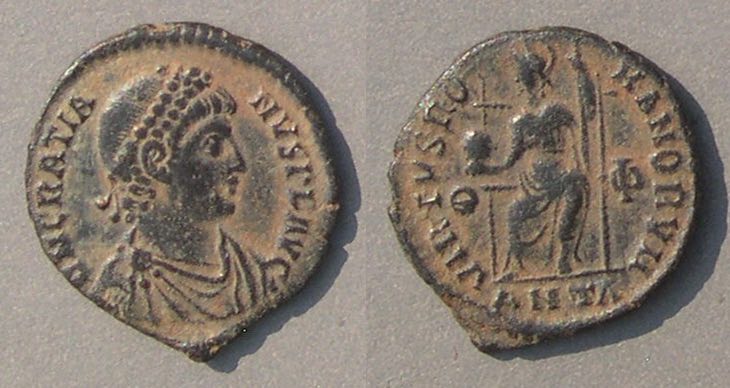 Gratian, 367-383
Gratian, 367-383
18 mm. 2.35 grams.
DN GRATIANVS PF AVG
VIRTVS ROMANORVM
Roma seated frontal, head left, holding globe and long scepter
Θ Φ
ΑΝΤΑ
RIC Antioch 50a, page 288.
Esty type 19.
An excellent example. Ex Kern at the Chicago International Coin Fair in 1995 [my ticket, but not one from him]
Nicer than any on vcoins and lower priced than every one on vcoins! [$39 SOLD]
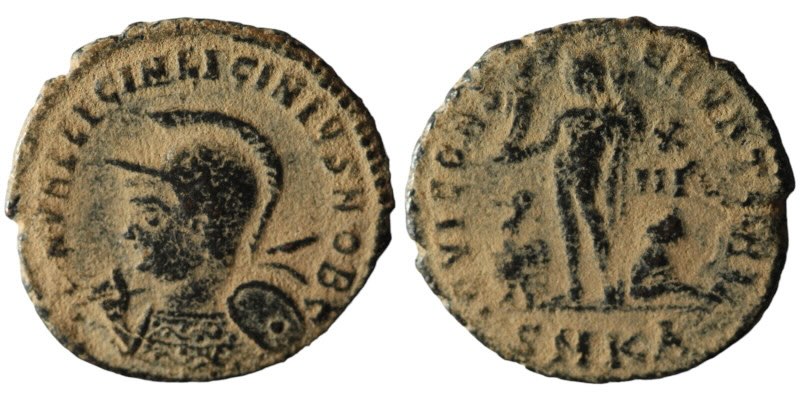 Licinius II, 317-324
Licinius II, 317-324
Helmeted bust left
XIIΓ denomination.
SMKA for Cyzicus
[$8]
Varus of "Varus, Give me back my legions!" fame. (He lost the Battle of the Teutoberg Forest and lost three legions in 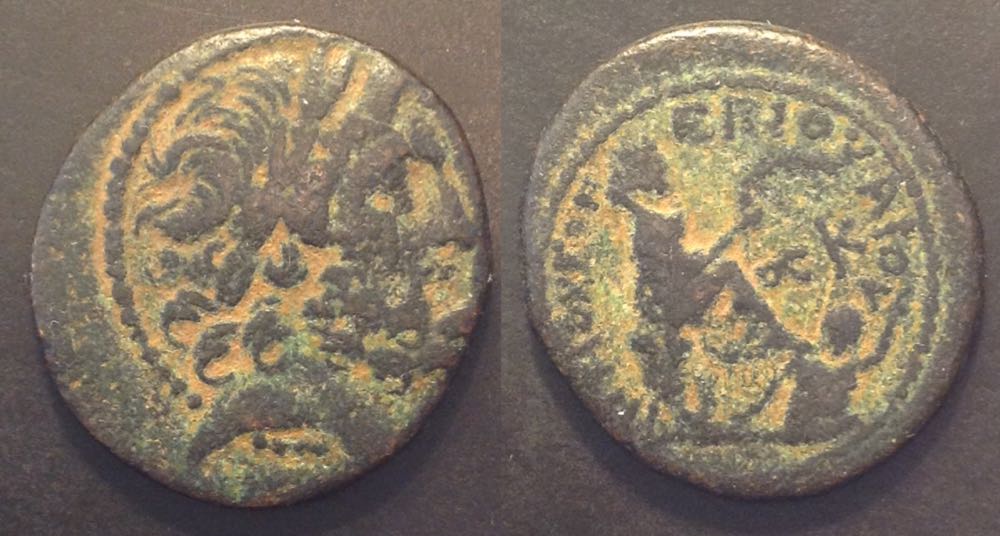 the battle.)
the battle.)
21-20 mm. 6.11 grams.
Struck at Antioch while he was "legate" there before he went to the Rhine under Augustus. See his name?
VAPOV at 3:00 and the year < = 6/5 BC.odd symbol> K for year 26. The year symbol as an archaic "stigma" for "6". "K" is "20".
Zeus head right
Tyche of Antioch seated rigtht, river god swimming below
ANTIOXEΩN EPI OYAPOV
RPC I 4245, page 625.
My cost was $61 in 2006. Here, $61 SOLD.
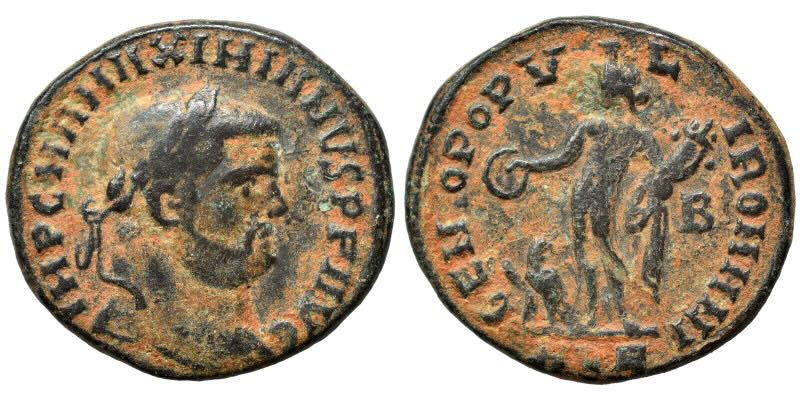 Maximian follis
Maximian follis
25 mm. 9.09 grams.
struck by
Domitius Domitianus at Alexanderia, Egypt
distinguished by the eagle at his feet left.
An interesting type struck by a usurper attempting to curry favor with the central emperors.
For the story, see my page: http://augustuscoins.com/ed/usurpers/Usurpers.html
IMP C M A MAXIMIANVS PF AVG
and B in the reverse right field
RIC VI Alexandria 18b
[$57 SOLD] None on vcoins or MA-Shops.
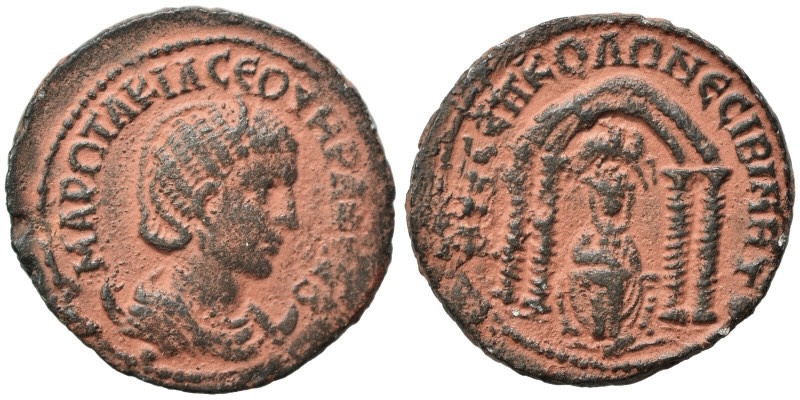 Otacillia Severa, wife of Philip I (244-249)
Otacillia Severa, wife of Philip I (244-249)
Struck at Nisibis, Mesopotamia
25 mm. 9.90 grams. Repatinated.
NECIBI on the coins.
Obv: MAP ΩTAKIΛ CЄOYHPAN CЄB,
(Marcia Otacilia Severa Sebasta)
diademed and draped bust right, on crescent.
Rev: IOY CЄΠ KOΛΩ NЄCIBI MHT,
(Julia Septimia Colonia Nisibis Metropolis)
[This "Julia" is a family name for Philip.]
Tetrastyle temple containing statue of city goddess seated facing; above her head, ram (Aries) leaping right, head turned back; below, river god Mygdonius swimming right.
References: Sear Greek Imperial Coins 4065. BMC 27. SNG Copenhagen 244. RPC VIII "unassigned; ID 2575." Her name and the city name are both very clear. [$45] SOLD The diameter of a quarter but twice as thick.
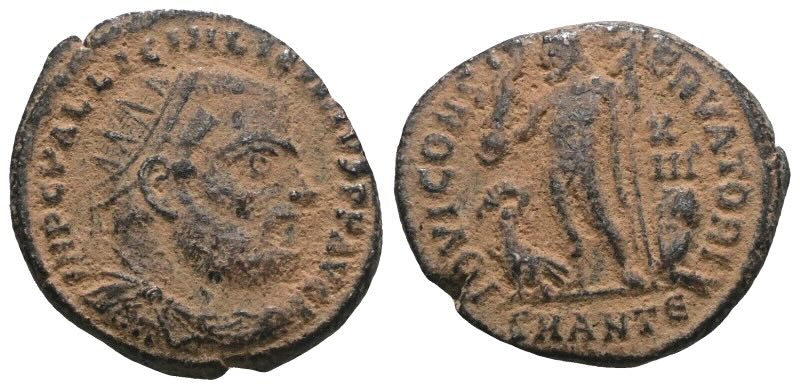 Licinius, 308-324
Licinius, 308-324
19-17 mm
IOVI CONSERVATORI
XIIΓ for 12 1/2, the denomination.
SMANTЄ
[$9]
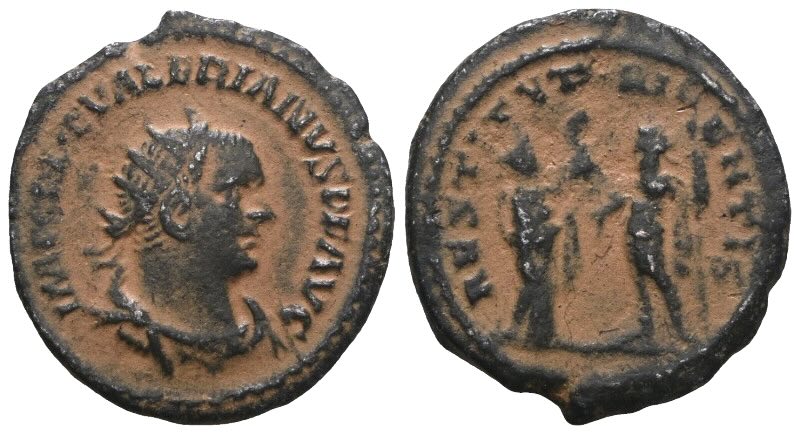 Valerian, 253-260
Valerian, 253-260
22 mm. 3.44 grams. Repatinated.
RESTITVT ORIENTIS
"Restorer of the East", which may be the most ironic legend on a Roman coin, given that he was captured alive by Shapur II and lively out his life in captivity after losing the East.
[$19]
 Carus, 282-283
Carus, 282-283
21 mm. 2.97 grams. Repatinated
PROVIDENTIA AVG
Δ in exergue
He reigned only aboout 10 months.
Where else can you find a coin of a less-than-one-year ruler for only
[$17 SOLD] + $2 shipping?
 Licinius
Licinius
18 mm. 2.32 grams. Repatinated.
IMP LICINIVS AVG
308-3234
VIRTVS EXERCIT
VOT XX on banner
Two captives
AQS
RIC Aqulieia 51
[$15 SOLD]
 Maximinus II
Maximinus II
22-21 mm. 6.31 grams. Thick.
GENIO EXERCITVS altar
ANT
RIC VI Antioch 147c, strck 310-311
[$9 SOLD]
 Constantius, as Caesar, 293-305
Constantius, as Caesar, 293-305
19 mm. 2.99 grams.
CONCORDIA MILITVM
ANT for Antioch
[$12]
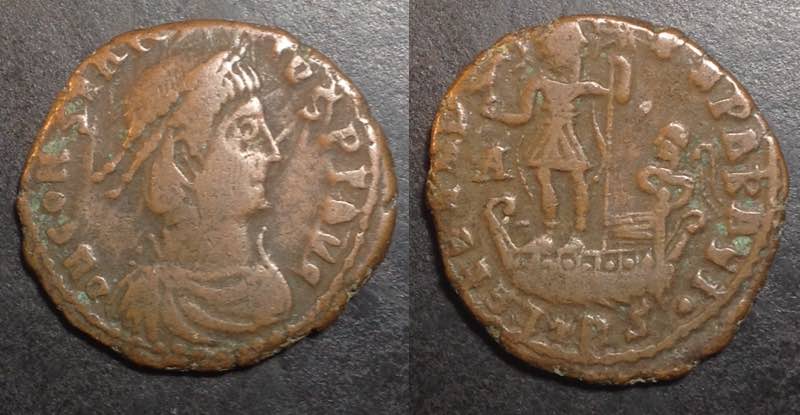 Full-sized ancient imitation.
Full-sized ancient imitation.
Constantius II
FEL TEMP REPARATIO
galley
23 mm. 6.16 grams (Heavier than the official originals!)
TRS for Trier.
Found in England.
Bought at Baldwin's in London in 2002.
Full-size FEL TEMP REPARAYIO imitations are rare.
[$85]
 Enlarged! (Because the portrait is so great!)
Enlarged! (Because the portrait is so great!)
Look at it closely.
Philip I, 244-249, His first isssue, dated to 245. He does not have coins dated to 244.
23 mm. Antoninianus. 12:00. 3.74 grams.
IMP M IVL PHILIP{PVS AVG
Magnificent portrait right on a large flan.
PM TRP II COS PP
Sear 3.8843
RIC 2b. Plate 5.16.
If you only want one coin of Philip for your portrait series, this could be the one. [$145]
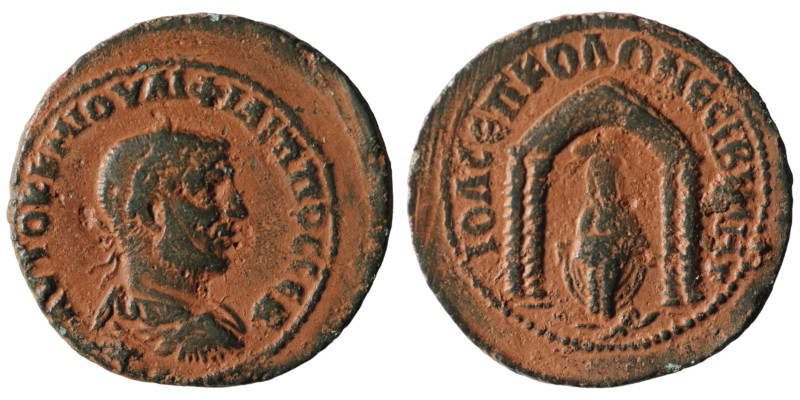 Philip I, 244-249
Philip I, 244-249
Struck at Nisibis, Mesopotamia
26-25 mm. 9.31 grams. Repatinated.
AVTOK K M IOVΛI ΦIΛIΠΠOC CЄB
(Autokrater Caesar Marcus Julius Philippus Sebastos)
The beard makes it Philip I.
Rev: IOY CЄΠ KOΛΩ NЄCIBI MHT,
(Julia Septimia Colonia Nisibis Metropolis)
[This "Julia" is a family name for Philip.]
Tetrastyle temple, with triangular pediment, containing statue of city goddess seated facing; above her head, ram (Aries) leaping right; below, river god Mygdonius swimming right.
Sear Greek Imperial Coins 3970. BMC Mesopotamia Nesibi [sic, that is how it is spelled on coins, although it is spelled "Nisibis" in literature] 17. RPC VIII "unassigned; ID 2824."[$43 SOLD]
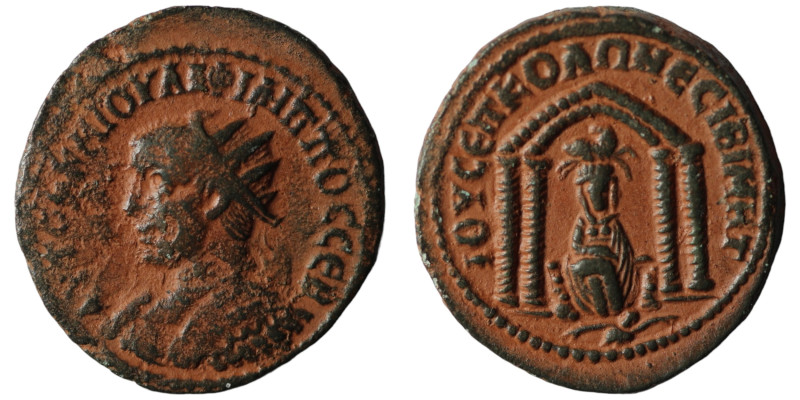 Philip II
Philip II
26-25 mm. 11.28 grams. Repatinated.
Struck at Nisibis, Mesopotamia.
Read more about Nisibis here: http://augustuscoins.com/ed/Nisibis/Nisibis.html
AVTOK K M IOVΛI ΦIΛIΠΠOC CЄB
(Autokrater Caesar Marcus Julius Philippus Sebastos)
The young face makes it Philip II.
Nisibis sometimes distinguished the two Philips by having Philip face right and Philip II face left.
Tetrastyle temple, with triangular pediment, containing statue of city goddess seated facing; above her head, ram (Aries) leaping right; below, river god Mygdonius swimming right.
Rev: IOY CЄΠ KOΛΩ NЄCIBI MHT,
(Julia Septimia Colonia Nisibis Metropolis)
[This "Julia" is a family name for Philip.]
Sear Greek Imperial 4157. BMC Mesopotamia Nesibi [sic] 21, attributed there to Philip I, with a footnote "Some of these may be of Philip Junior, especially nos. 21-4 on which the face appears to be beardless."
RPC VIII "unassigned; ID 2962."
Superb reverse! The legend and city name couldn't be clearer. The obverse shows corrosion as seen in the photo, but for a coin of this Mesopotamian city you can't find a more-beautiful reverse. [$42 SOLD] Larger than a quarter and twice as thick.
 Helena, mother of Constantine the Graet
Helena, mother of Constantine the Graet
20-18 mm. 2.76 grams. Repatinated.
Struck 325-6 at Antioch
SECVRITAS REIPVBLICE
Lovely! Well-centered with full legends, very clear [$49 SOLD]
 Galeria Valeria
Galeria Valeria
Wife of Galerius
Daughter of Diocletian
25 mm. 7.48 grams. Large. Repatinated.
ANT for Antioch, H in right field (H for 8, the officina number in Greek)
RIC VI Antioch 151, strck 310-311
[$48]
 Ionia, Teos. Tiny!
Ionia, Teos. Tiny!
6.2-5.9 mm. 0.12 grams.
Griffin's head right with protruding tongue.
Incise squre divided into four parts.
SNG Turkey I Kayhan 603 (0.16 grams) "475-450 BC).
Rosen 604, page 29 (0.18 grams) "tetartemorion, 520-478 BC"
Klein 481 is this type and 0.23 grams.
flan chip behind head. [$23]
Would this be the smallest coin in your collection?
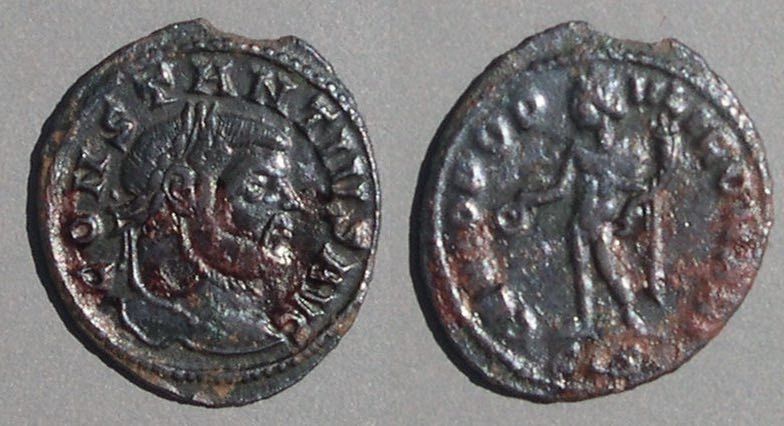 Constantius, 293-305-306
Constantius, 293-305-306
Quarter follis, struck 305-306 as Augustus.
This denomiatnoin was struck at Siscia and for only about a year, right around 305-306.
GENIO POPVLI ROMANI like a follis, but much smaller.
20-18 mm. 2.00 grams.
SIS for Siscia mint
RIC 169a "R2" page 8475, but it is not that rare anymore.
Hunter --, Cayon --. Sear IV 14192v (The reverse comes combined with two different obverse legends and my coin has the shorter obverse legend; Sear's has the longer.)
[$23 SOLD]
 Sabina, wife of Hadrian
Sabina, wife of Hadrian
117-138
Anepigraphic reverse
Venus Victrix standing right, leaning on column, before her to right, shield.
RIC II 412, page 469 "R"
BMC III Hadrian 920v page 356, plate 65.5 (has shield behind column)
Highly artistic. Worn. Elegant design. Slabbed. [$179]
CNG had one, $1200+20% = $1440: https://www.acsearch.info/search.html?id=12108117
Leu had one: $430 + 20% = $516:

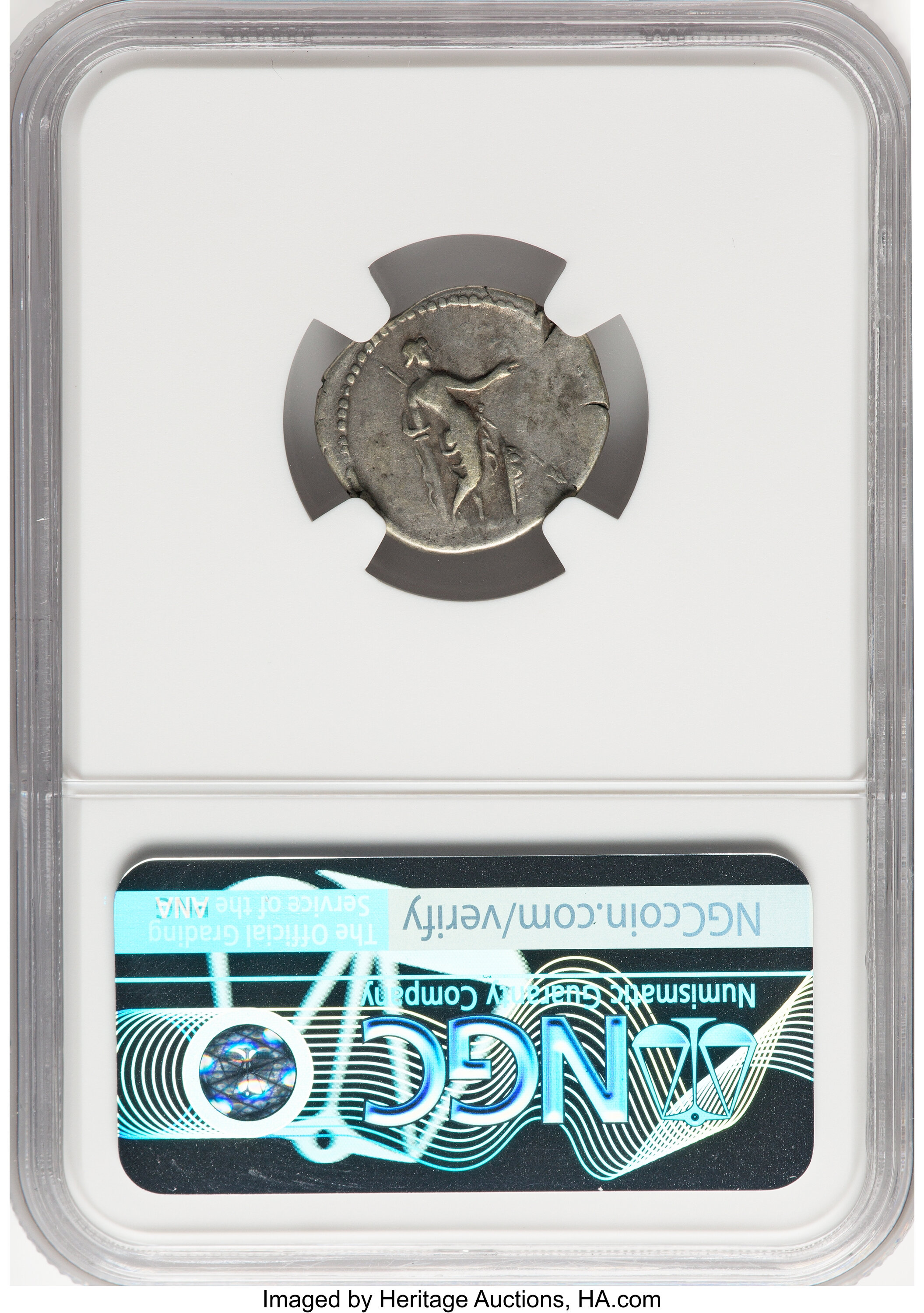
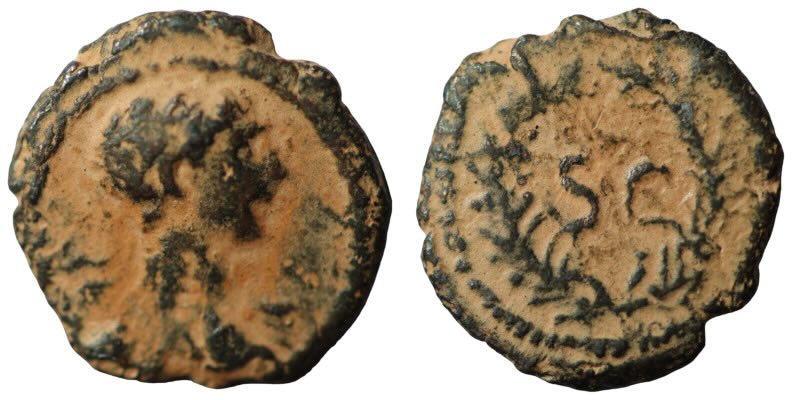 Trajan, 98-117
Trajan, 98-117
The smallest Roman denomination! Sometimes called an "uncia." It is much smaller than a quadrans.
Struck very near the end of his reign, c. 117.
12.3- 10.1 mm. 0.75 grams. Tiny!
His bust right with no legend.
"SC" in wreath.
Sear II 3250, page 170 "Rome, 112-117"
RIC Trajan 443, says probably 101-103 (unlikely, since there is a short-lived similar type of Hadrian)
BMC 1883. p. cvi "Very probably of Roman mintage--possibly Antioch."
The only other coin of a similar type is of Hadrian, distinguished only by its portrait of Hadrian.
Recognizable bust of Trajan and clear "SC" in wreath. Tiny! Nice natural earthen cover. [$39, reduced to $36] (There is another one, below)
It is nice considering it is so small. PRC III 3681 Antioch "chalkous" "product of Rome." "Struck for circulation in Syria".
 Anonymous AE. Reign of Maximinus II, 310-313 AD.
Anonymous AE. Reign of Maximinus II, 310-313 AD.
16mm.
Antioch mint.
GENIO ANTIOCHENI, Tyche of Antioch seated facing on rock, river god Orontes swimming at her feet. Reverse - APOLLONI SANCTO, Apollo standing left pouring from patera and holding lyre, S in right field, SMA in exergue. McAlee170a // Vagi 2954.
[$22 SOLD]
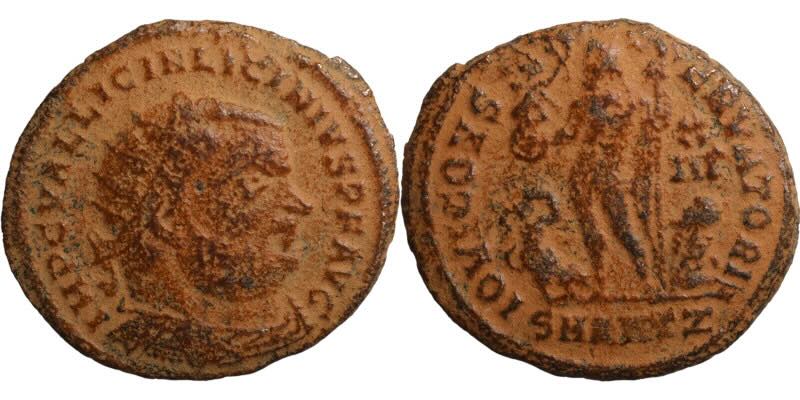 Licinius
Licinius
19.5-17.9 mm.
IOVI CONSERVATORI
SMANTZ for Antioch mint
X II Γ in the field for 12 1/2, half the "25" denomination.
eagle holding wreath, captive, and Jupiter holding Victory on globe, crowning him.
[$8]
 Valerian II, son of Gallienus
Valerian II, son of Gallienus
VICTORIA PART
I love coins relating to wars between Roman and Persia. This is a scarce type (primarily for Valerian I) which ironically references Valerian's (untimately disastrous) war with "Parthia" (by then we call them Sasanians)
Comparable coins on vcoins cost far more. [$59]
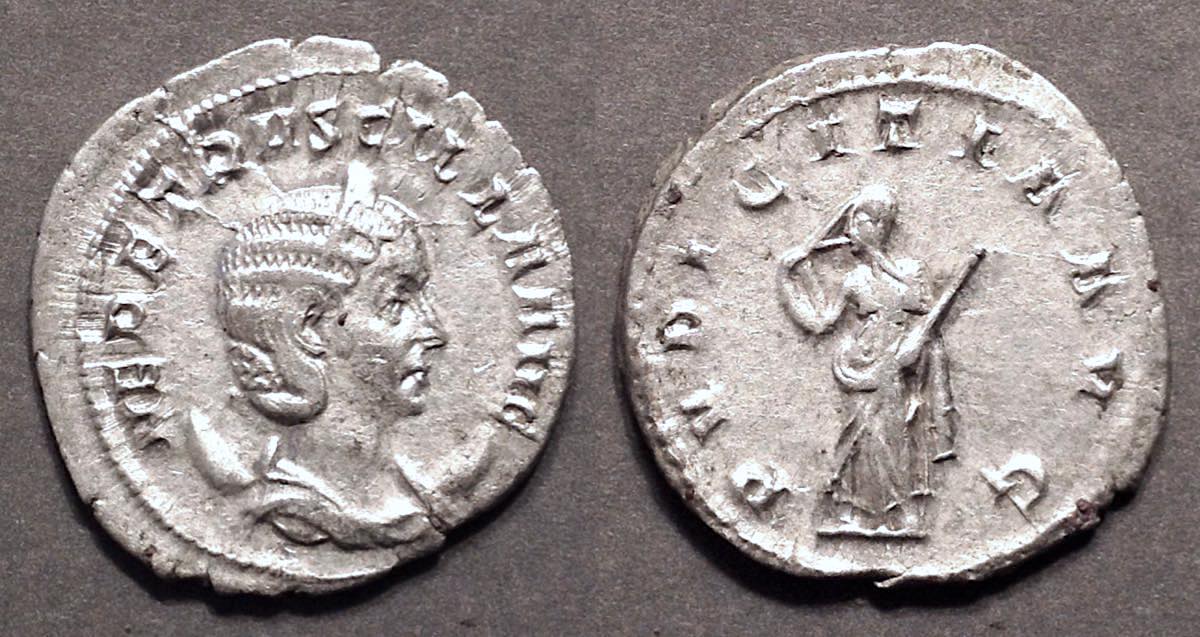 A lovely portrait for the portrait series.
A lovely portrait for the portrait series.
Herennia Etruscilla, wife of Trjan Decius who reigned 249-251
HER ETRVSCILLA AVG
Please please go look at other coins of Herennia. She often/usually has an unattractive face. You have to look hard to find one as pleasing as this one.
PVDICTIA AVG (modesty)
RIC IV.III (under Trajan Decius) 58b, page 127, plate 11.4. (RIC's coin is not quite as nice)
Sear III 9494.
Ancient coins are ancient art, as well as history. This particular coin is art of a higher order than almost all of her other coins.
[$145, reduced to $125 + $6 shipping in the US]
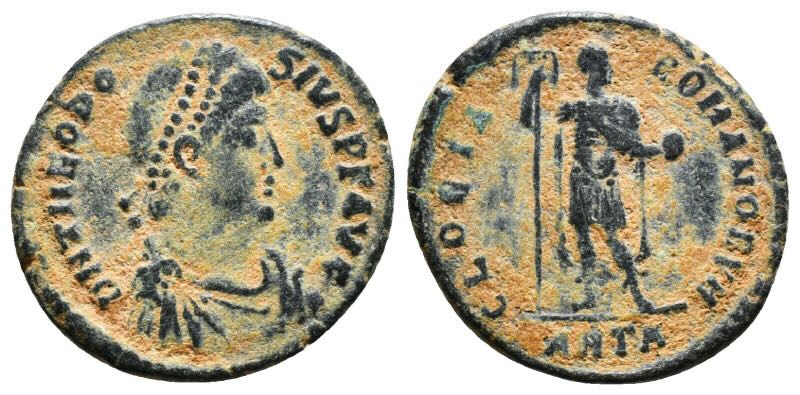 Theodosius, 379-395
Theodosius, 379-395
AE 2. 22 mm.
GLORIA ROMANORVM
ANTB Antioch mint
[$22]
NOTE: This page now includes Tetrarchal coins (below). It incorporates the previous "Tetrarchy" page.
Please compare prices with those on acsearch and vcoins and any other sites you use. I intend my prices to be below the prices for comparable coins on vcoins.
Begin Roman coins in chronological order
Roman Republican
 Roman Republican semis imitation from Spain
Roman Republican semis imitation from Spain
(which rarely had its own mint so locals issued imitations to supply the need for small change)
First century BC. c. 100-25 BC.
Small. 17-15 mm. 2.19 grams.
Head of Saturn right; S (mark of value) behind
Prow right; horizontal S (mark of value) above. Cf. Burgos R46.
cf CNG https://cngcoins.com/Coin.aspx?CoinID=270492
for a very similar coin, not as nice, for $60 plus fees.
Crawford "Unoffical imitations and small change under the Roman Republic" AIIN 29 (1982) plate XI, 21. Also, plate II 19 (same dies!)
"Found almost always in the south of Spain, near Seville"
Better than the CNG piece. [$49, reduced to $45]
This coin cited in Rippolès and Witschonke, "The unofficial Roman Republican semisses struck in Spain" in Studies in Ancient Coinage in Honor of Andrew Burnett, 2015. #116h, not illustrated.
***** I also have a page of numismatic literature (ancient-coin auction catalogs, books) for sale.
Roman Imperial Silver and AE
Second Century
Trajan (98-117)
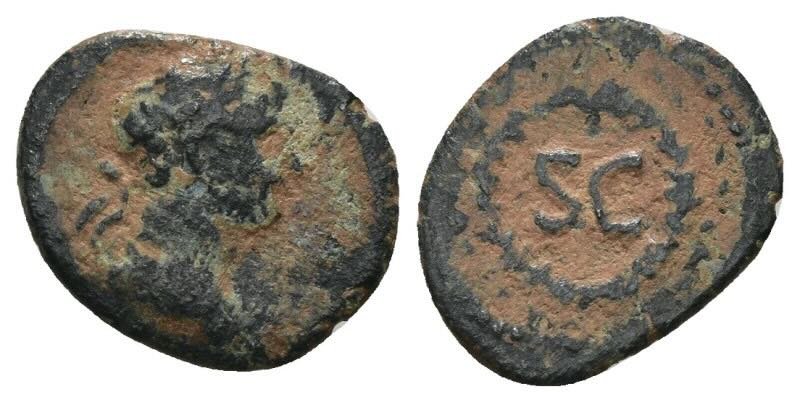 Trajan, 98-117
Trajan, 98-117
The smallest Roman denomination! Sometimes called an "uncia." It is much smaller than a quadrans.
Struck very near the end of his reign, c. 117.
12.5- 10.0 mm. 0.75 grams. Tiny!
His bust right with no legend.
"SC" in wreath.
Sear II 3250, page 170 "Rome, 112-117"
RIC Trajan 443, probably 101-103 (unlikely, since there is a short-lived similar type of Hadrian)
BMC 1883. p. cvi "Very probably of Roman mintage--possibly Antioch."
The only other coin of a similar type is of Hadrian, distinguished only by its portrait of Hadrian.
Recognizable bust of Trajan and clear "SC" in wreath. Tiny! Nice natural earthen cover. [$24, reduced to $19 SOLD]
It is nice considering it is so small. PRC III 3681 Antioch "chalkous" "product of Rome." "Struck for circulation in Syria".
Hadrian (117-138)
 Hadrian, 117-138. Struck c. 117. The smallest Roman denomination! Sometimes called an "uncia." It is much smaller than a quadrans.
Hadrian, 117-138. Struck c. 117. The smallest Roman denomination! Sometimes called an "uncia." It is much smaller than a quadrans.
Struck very near the beginning of his reign, c. 117. (The only other coin of a similar type is of Trajan, which is distinguished only by its portrait of Trajan. See the next coin.)
10.5-9.5 mm. 1.15 grams. Tiny!
His bust right with no legend.
"SC" in wreath.
Sear II 3250, page 170 "Rome, 112-117"
RIC Hadrian 629b.
Sear II 3705 page 170
Tiny! Good portrait for the small size. [$39, reduced to $33 SOLD] PRC III 3681 Antioch "chalkous" "product of Rome." "Struck for circulation in Syria". It seems these of Hadrian are poorly made compared to those of Trajan. This one is nice "for type."
Third Century:
Central Empire, Claudius II (268-270) and later:
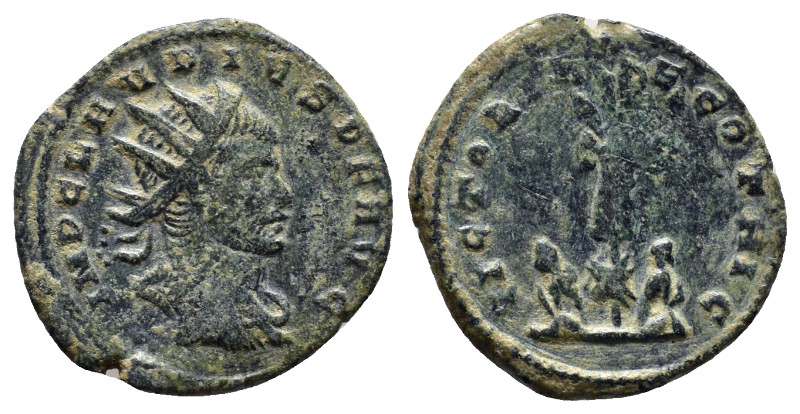 Claudius II, Gothicus, 268-270
Claudius II, Gothicus, 268-270
20.7-19.2 mm. 3.13 grams.
IMP CLAVDIVS P F AVG. Radiate and cuirassed bust right.
With his nickname in the reverse legend!
VICTORIAE GOTHIC
Trophy with two captives
One of his best types for having "GOTHIC" in the legend.
[$27 SOLD]
For a page of ancient imitations from the third century, see here.
Tetrarchy begins here!
Diocletian (284-305)
Maximian (286-305 and later)
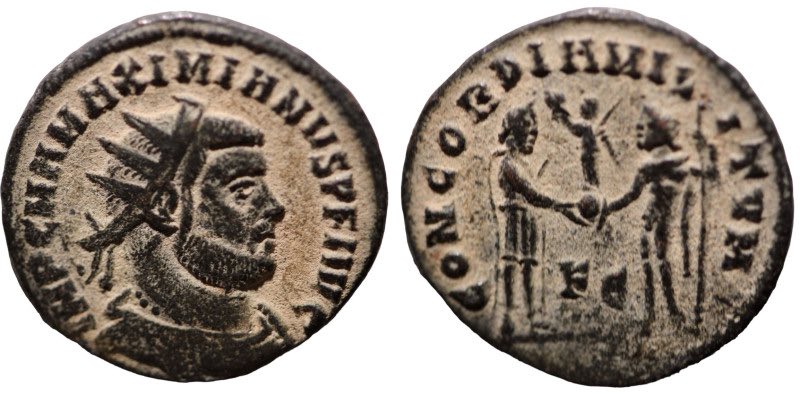
Maximian. (286-305 AD).
20mm, 2.71g
Cyzicus
IMP C M A MAXIMIANVS P F AVG. radiate cuirassed bust of Maximian right.
CONCORDIA MILITVM. Jupiter standing left presents Victory on a globe to Maximianus standing right. White cover. [$23]
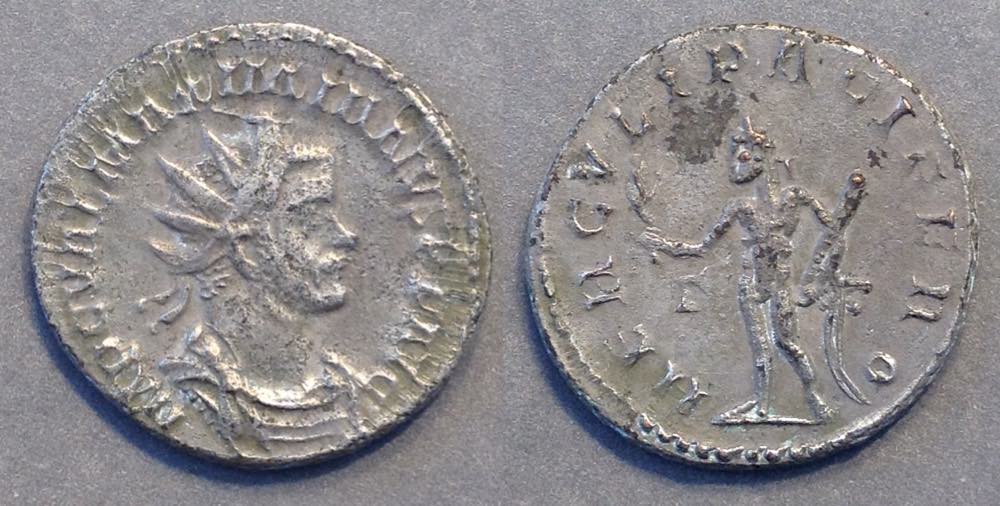 Maximian
Maximian
21-20 mm. 4.21 grams.
HERCVLI PACIFERO
Hercules standing left holding olive branch in right and club and lion-skin in left
Γ in field left, nothing in exergue.
RIC V.II Maximian 371, page 263 "Lugdunum, 288"
Bastien 95 p.134, 3rd emission, 4th officina (286 AD)
Sear 13131.
Good silver. Somewhat porous. Lots of reverse detail. [$35, reduced to $29]
Club and lion-skin!
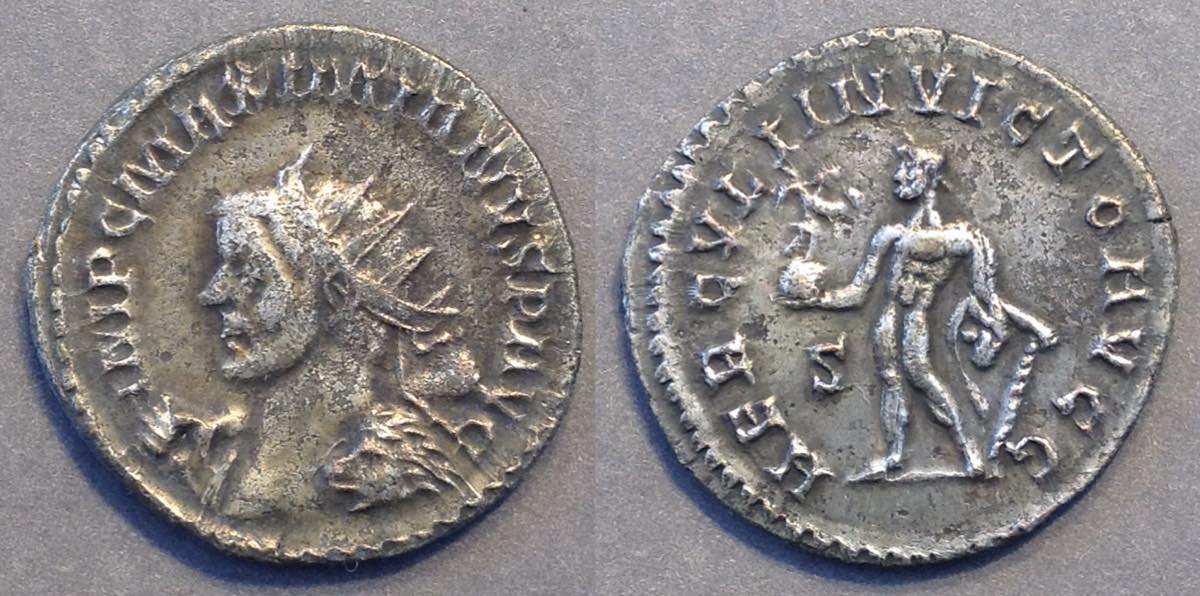 Maximian, 286-305.
Maximian, 286-305.
22 mm. 4.23 grams. Heavy with better silver than typical.
IMP C MAXIMIANVS AVG
HERCVLI INVICTO AVGG
Hercules standing left holding Victory on globe, lion-skin over left arm, leaning on club.
S in left field, nothing in exergue.
Obverse: radiate bust left holding club over far shoulder, lion skin over near (his left) shoulder.
RIC V.II Maximian 367, page 263, "Lugdunum, 289"
Bastien 190 p.152, 5th emission, 2nd officina (287-289 AD).
Sear 13132.
Rare bust type. Lots of silvering. [$295, reduced to $235, reduced to $195] Please compare with prices elsewhere.
 Maximian
Maximian
21-20 mm. 3.02 grams.
HERCVLI PACIFERO
Hercules standing left holding olive branch in right and club and lion-skin in left
Δ in field left, nothing in exergue.
RIC V.II Maximian 371, page 263 "Lugdunum, 288"
Bastien 95 p.134, 3rd emission, 4th officina (286 AD)
Sear 13131.
[$39, reduced to $34, reduced to $27]
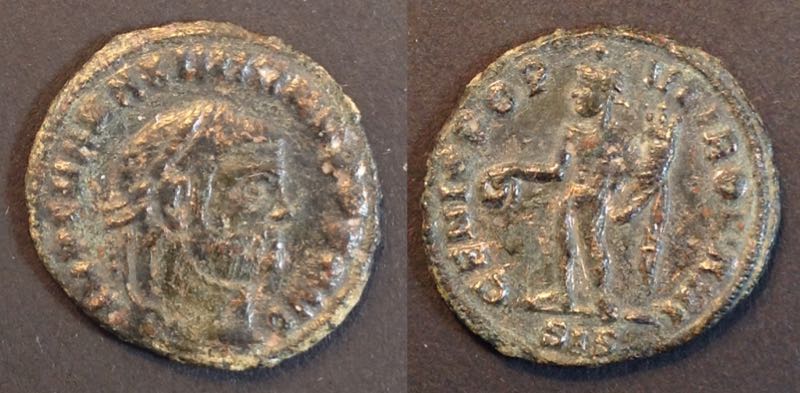 Quarter Follis of Siscia
Quarter Follis of Siscia
19 mm.
Maximian
IMP C MA MAXIMIANVS PF AVG
GENIO POPVLI ROMANI
SIS
This is not the usual full-size follis, rarther the scarcer (but not rare) "quarter follis".
RIC Siscia 146, "R3" (RIC rarities are out of date.)
plate IX
Failmezger 29 [$16, reduced to $14]
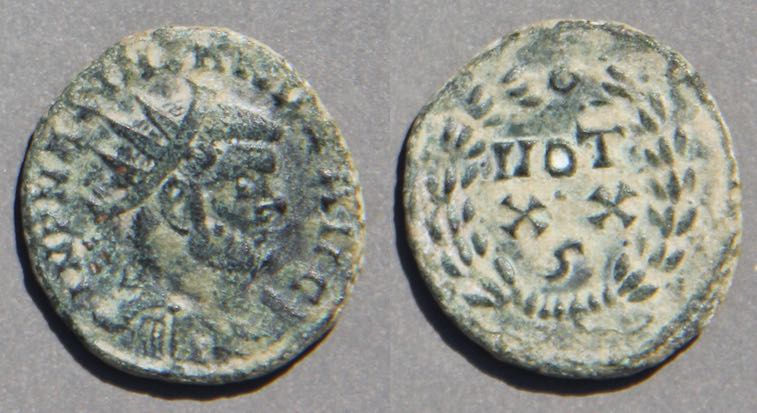
[$39, reduced to $35 SOLD] Maximian post-reform radiate. 20 mm.
VOT / XX in wreath, struck 297-8.
Vows for 20 years of reign (which is what Diocletian wanted and imposed)
RIC Rome 85b, "Scarce" and this officina is unlisted. (It is listed for nearby issues, but not this type.)
Should it be worth a lot more for being "not in RIC"? Maybe a little. If that appeals to you, and it does to most collectors somewhat, buy this one. Most collectors don't have any coins "not in RIC."
Constantius I (293-305-306)
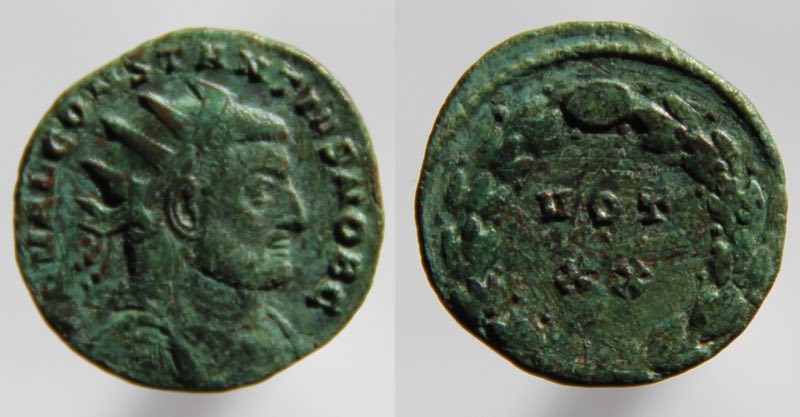 Constantius, 293-305-306
Constantius, 293-305-306
20-19 mm
Struck as Caesar
IMP VAL CONSTANTIVS NOB C
VOT XX in wreath
No visible officina number
RIC VI Rome 87e variety. "c.297-8." Footnote 2 says some apparently have no officina number. [$49, reduced to $33]
VOT XX is hard to explain for Constantius with this date. It might be the vows of Diocletian (not Constantius) reconfirmed at year 15 (as proposed by RIC). It might be the coin is really from c. 303 (as the Carthage coins above) and this is vows suscepta for Constantius on the occasion of his ten-year vows. Of, it might be really from c. 303 and the vow number belongs to Diocletian. It is certainly the case that vow numbers can belong to the senior ruler and not the ruler named on the coin.
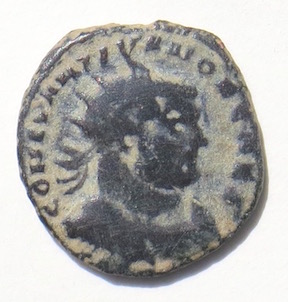

[$39, reduced to $23] Constantius I. Struck c. 297-8 at Rome. 19 mm. 3.14 grams.
VOT XX A in wreath.
RIC VI Rome 88a. page 360.
A reference to the "20 years" intended for the tetrarchy.
Rare. None on vcoins or MA-Shops as of this writing.
Galerius (293-305-311)
Maxentius (306-312)
Maximinus II (310-313)
 Maximinus II, 305-310-313
Maximinus II, 305-310-313
19 mm.
Struck 305-306
quarter follis
GENIO POPVLI ROMANI
SIS for Siscia
RIC Siscia 171b
The short version of his obverse legend
MAXIMINVS NOB C [$33, reduced to $17]
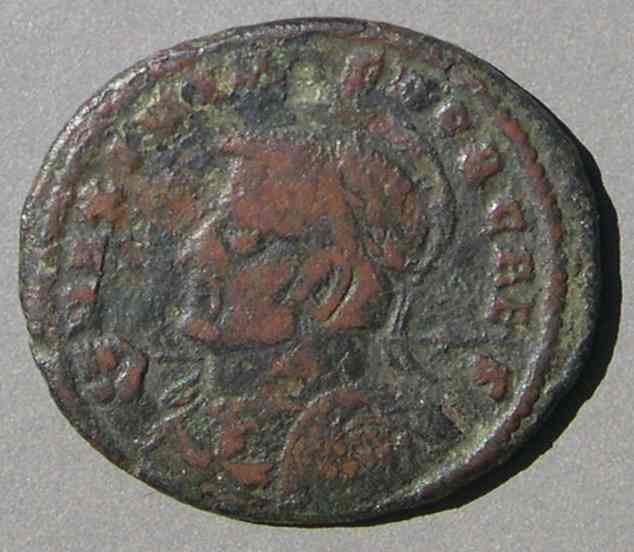
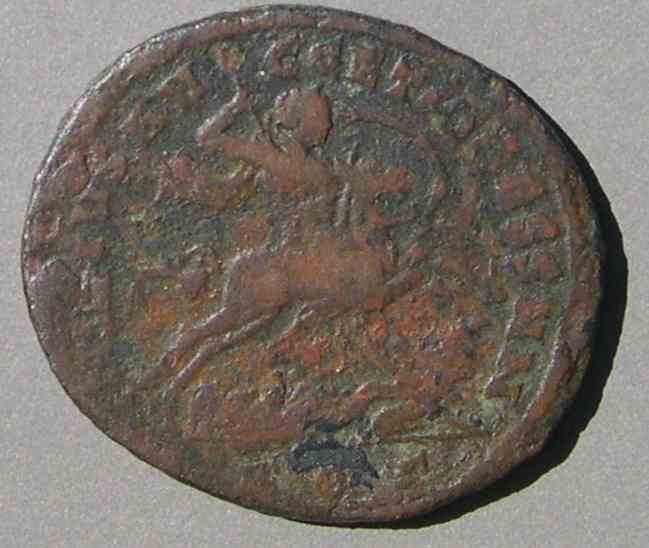
Maximinus II, Daza. 305-310-313 AD.
Struck as Caesar, c. 305-6 at Aquileia. RIC VI Aquileia 68b "scarce" (I'd say "rare")
Large AE30-26. Horseman spearing fallen foe.
VIRTVS AVGG ET CAESS NN
Helmeted bust left with spear over far shoulder. The coin is a little less red than the image on my screen. Rare type (both obverse and reverse are unusual) [$39, reduced to $37 SOLD Civic Pagan Coins of the time of Maximinus II (c. 310)
[SOLD]
\Licinius (308-324)
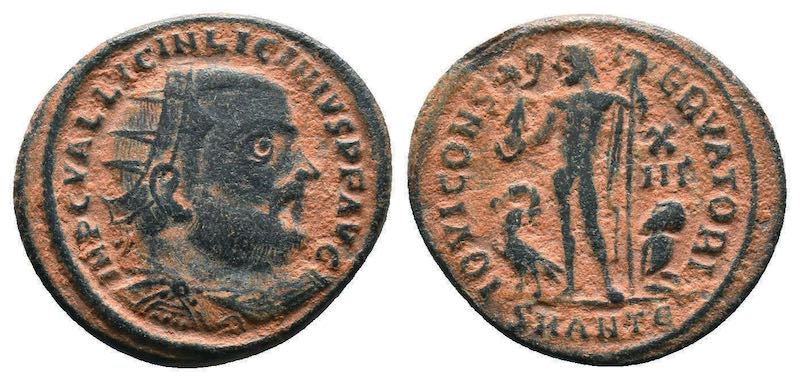 Licinius I, 308-324
Licinius I, 308-324
21-19 mm. 2.79 grams.
Radiate 12 1/2 denomination.
IOVI CONSERVATORI
Jupiter holding Victory, eagle and captive below.
X/IIΓ in field (12 1/2)
SMANTE
RIC Antioch 35
Lovely rust and black patina. [$26, reduced to $22]
 Licinius, 308-324
Licinius, 308-324
21 mm. 3.23 grams/
IOVI CONSERVATORI
Jupiter holding Victory on globe, eagle below
SIS
Siscia mint
Lovely orange highlights
[$19 + $2 shipping if this is all you order]
(Totals more than $25 up to $50 cost $3 shipping.)
 Licinius, 308-324
Licinius, 308-324
Radiate Fraction,
18 mm. 3.37 grams.
Alexandria, 321-324. IMP C VAL LICIN LICINIVS P F AVG Radiate, draped and cuirassed bust of Licinius I to right. Rev. IOVI CONSERVATORI AVGG / X / IIΓ / SMALB Jupiter standing front, head to left, holding Victory on globe in his right hand and long scepter in his left; at feet, eagle to left, holding wreath in beak; to right, captive seated right, his head turned back toward Jupiter. RIC Alexandria 28.
The X / IIΓ means 12 1/2, which is half of 25 and also 8 to 100, so it was probably an attempt to make a denomination fit with the coins (whichever they were) valued at 100 (denarii?).
I love the earthen highlighting. [$25, reduced to $18]
Licinius II (317-324)
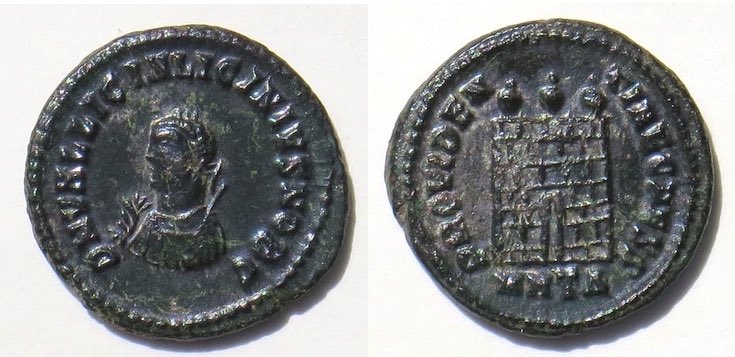
Licinius II, 317-324
19 mm. Tiny head left with scepter and mappa, struck 317
RIC VII Heraclea 19
"Camp gate" PROVIDENTIAE CAESS, MHTDelta
very little wear, silvering mostly tarnished to glossy black
A really cute tiny head! Splendid! [$59, reduced to $47]
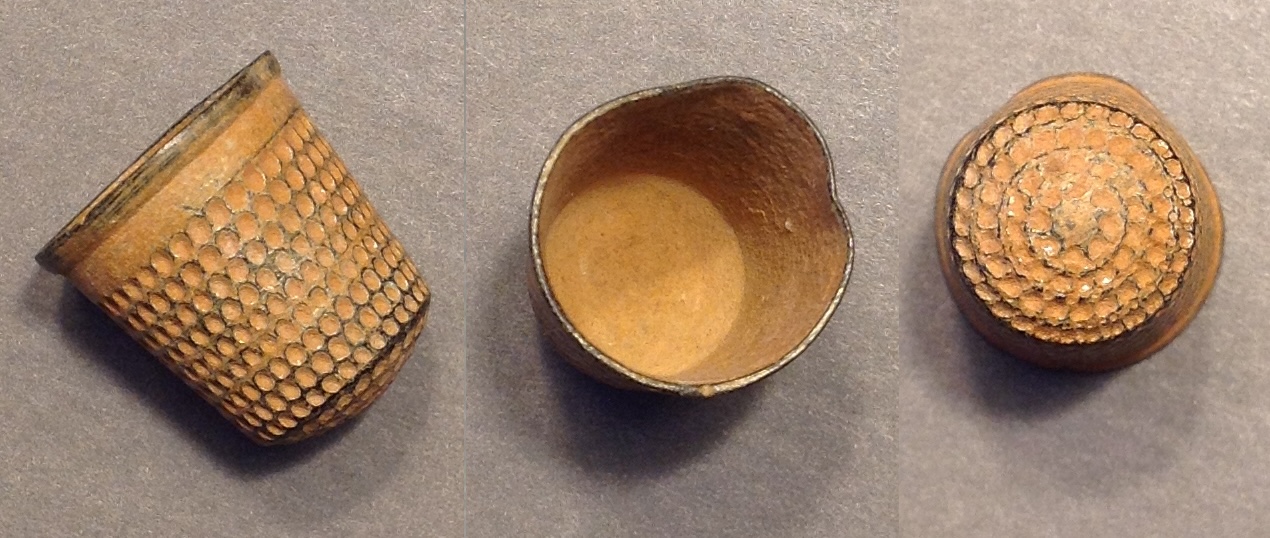 Okay, it is not an ancient coin, and not ancient, but it is interesting. A small thimble, 14 mm diameter, 15.3 mm deep. (Too small for even my little finger.)
Okay, it is not an ancient coin, and not ancient, but it is interesting. A small thimble, 14 mm diameter, 15.3 mm deep. (Too small for even my little finger.)
I know almost nothing about it. I bought it from the "artifacts" section of an ancient-coin auction. Thimbles are a medieval invention, not ancient.
I will ship it in a small but strong box inside an envelope so it doesn't get crushed in the mail.
[$9, reduced to $7 + $6 shipping (It is too thick for a regular envelope)] (If you also order coins, they will not add to the shipping cost unless the coins are expensive.)
Return to the top of this page.
Next Page: Constantinian (306-364)
Second next: Roman of Valentinian and later (364-491 AD)
To order, or simply to ask me questions, write me, Warren, at

 .
. 
 Licinius II, 317-324
Licinius II, 317-324 the battle.)
the battle.)

 Licinius, 308-324
Licinius, 308-324 Valerian, 253-260
Valerian, 253-260


 Constantius, as Caesar, 293-305
Constantius, as Caesar, 293-305
 Enlarged! (Because the portrait is so great!)
Enlarged! (Because the portrait is so great!)


 Galeria Valeria
Galeria Valeria Ionia, Teos. Tiny!
Ionia, Teos. Tiny!
 Sabina, wife of Hadrian
Sabina, wife of Hadrian

 Trajan, 98-117
Trajan, 98-117
 Licinius
Licinius Valerian II, son of Gallienus
Valerian II, son of Gallienus A lovely portrait for the portrait series.
A lovely portrait for the portrait series. Theodosius, 379-395
Theodosius, 379-395 Honorius
Honorius
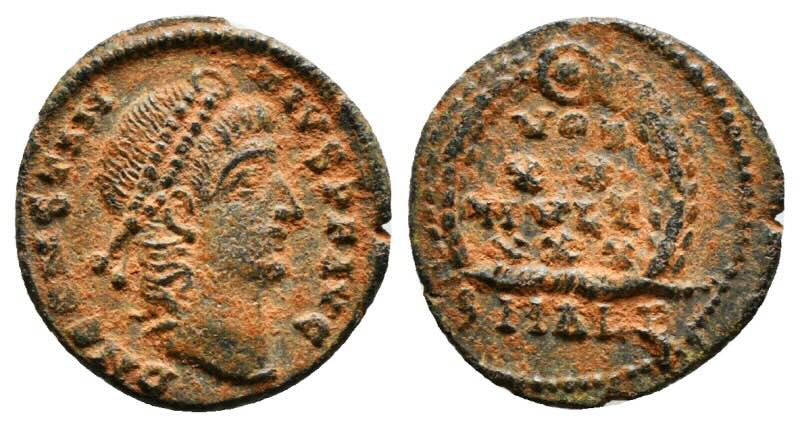 Constantius II
Constantius II Roman Republican semis imitation from Spain
Roman Republican semis imitation from Spain



 Maximian
Maximian Maximian, 286-305.
Maximian, 286-305. Maximian
Maximian Quarter Follis of Siscia
Quarter Follis of Siscia
 Constantius,
Constantius, 

 Maximinus II,
Maximinus II, 

 Licinius I, 308-324
Licinius I, 308-324
 Licinius, 308-324
Licinius, 308-324
 Okay, it is not an ancient coin, and not ancient, but it is interesting. A small thimble, 14 mm diameter, 15.3 mm deep. (Too small for even my little finger.)
Okay, it is not an ancient coin, and not ancient, but it is interesting. A small thimble, 14 mm diameter, 15.3 mm deep. (Too small for even my little finger.)